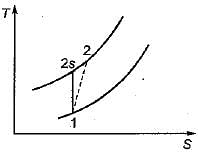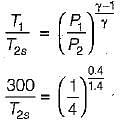Test: Compressors - 3 - Mechanical Engineering MCQ
20 Questions MCQ Test - Test: Compressors - 3
Which of the following statements are correct?
1. Surging is a local phenomenon while stalling affects the entire compressor.
2. Stalling is a local phenomenon while surging affects the entire compressor.
3. The pressure ratio of an axial compressor stage is smaller than that of a centrifugal stage.
1. Surging is a local phenomenon while stalling affects the entire compressor.
2. Stalling is a local phenomenon while surging affects the entire compressor.
3. The pressure ratio of an axial compressor stage is smaller than that of a centrifugal stage.
A large clearance volume in reciprocating compressor results in
| 1 Crore+ students have signed up on EduRev. Have you? Download the App |
If n is the polytropic index of compression and p2/p1 is the pressure ratio for a three-stage compressor with ideal intercooling, the expression for total work of three stage is
A P-v diagram has been obtained from a test on a reciprocating compressor. Which of the following represents that diagram?
When is the work required for compression of an ideal gas between two pressures in a reciprocating compressor minimum?
Which one of the following type of compressor is mostly used for supercharging of I.C. engine
Centrifugal compressors are suitable for large discharge and wider mass flow range, but at a relatively low discharge pressure of the order of 10 bars, because of
In a centrifugal compressor assuming the same overall dimensions, blade inlet angle and rotational speeds, which of the following bladings will given the maximum pressure rise?
The usual assumption in elementary compressor cascade theory is that
What, docs application of centrifugal air compressors lead to?
Degree of reaction in an axial flow compressor is defined as the ratio of static enthalpy rise in the
The flow in the vaneless space between the impeller exit and diffuser inlet of a centrifugal compressor can be assumed as
The optimum intermediate pressure p1 for a gas turbine plant operating between pressure limits p1 and p2 with perfect intercooling between the two stages of compression (with identical isentropic efficiency) is given by
Consider a two stage reciprocating air compressor with a perfect intercooler operating at the best intermediate pressure. Air enters the low pressure cylinder at 1 bar, 27°C and leaves the high pressure cylinder at 9 bar. Assume the index of compression and expansion in each stage is 1.4, and that for air R - 286.7 J/kg K, the work done per kg air in the high pressure cylinder is [Take 30.286 = 1.37]
Air (cp = 1 kJ/kgK, γ - 1.4) enters a compressor at a temperature of 27°C. The compressor pressure ratio is 4. Assuming an efficiency of 80%, the compressor work required in kJ/kg is [Take 0.250.286 = 0.67]





 = 3.5 x 286.7 x 300 (1.37 - 1) = 111 kJ
= 3.5 x 286.7 x 300 (1.37 - 1) = 111 kJ





















